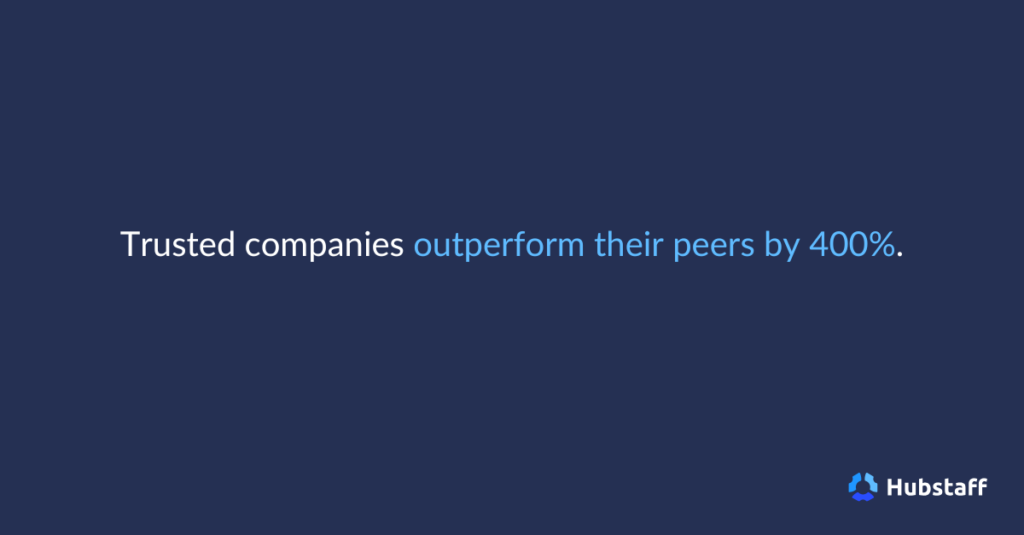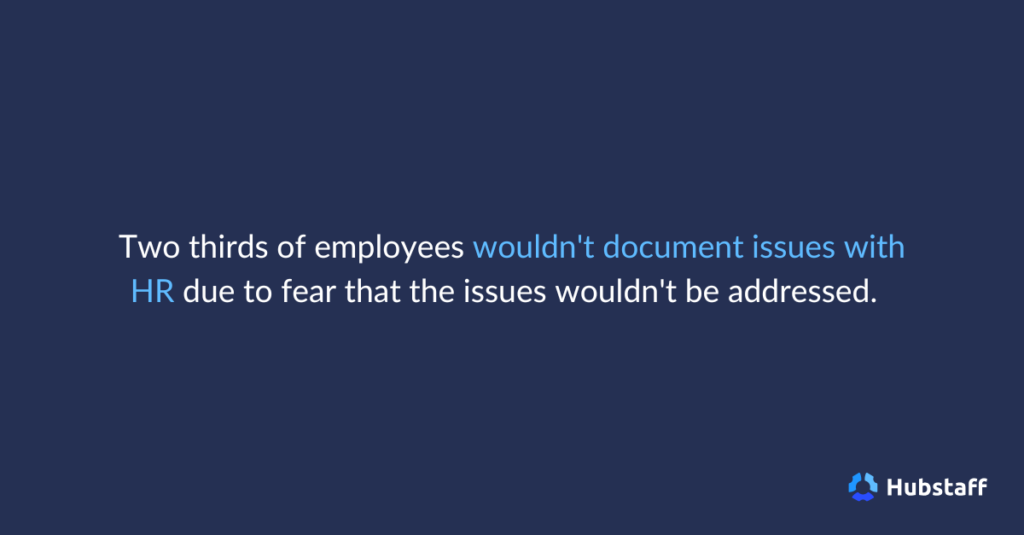Why is trust so important for employees and employers? Simply put, it leads to better outcomes for both parties.
For the past few years, Great Place To Work’s annual 100 Best Companies to Work For has proven time and again that when employees trust their employers, the company performs better.
Workplace trust impacts every aspect of team performance, from collaboration to retention. Building trust becomes even more important in remote environments (where face-to-face interactions are limited).
Business leaders know that building trust is the foundation of a healthy workplace culture. When trust is missing, teams struggle to operate efficiently, and the work environment suffers as a result.
Conversely, a culture rooted in trust leads to better employee well-being and empowers teams worldwide to perform at their best.
Boost your team’s efficiency with Hubstaff's productivity tools
What is trust in a remote workplace?
Trust in a remote workplace is the belief that everyone on the team will act with integrity, fulfill their responsibilities, and prioritize collective goals.
Trust is essential for driving employee engagement, maintaining employee satisfaction, and maintaining employee motivation — especially due to the potentially isolating nature of remote work.
Nearly 80% of employees trust their employers. However, remote work presents unique challenges to earning employees’ trust, like:
- Limited face-to-face interaction. Without in-person communication, trust must be built through consistent actions and clear communication.
- Perception of micromanagement. Excessive oversight negatively impacts trust and employee motivation.
- Building cohesion without informal moments. Remote teams miss out on coffee breaks, water cooler chats, happy hours, and other casual interactions that naturally strengthen high-trust companies.
Employee trust isn’t a “worry-about-it-later” perk of a highly evolved organization. It’s a requirement. Let’s take a look at the importance of building trust in a remote environment.
The importance of building trust in a remote environment
This Harvard Business Review leadership study found that high-trust businesses are over twice as likely to be high-performing revenue organizations than low-trust companies.
In fact, trusted companies outperform their peers by a staggering 400%.

With studies continually demonstrating how employee trust leads to increased profitability, leaders are racing to join the fight for employee trust.
Trust isn’t exclusive to office or remote teams — It’s a core component of every team’s culture.
Trust improves remote work productivity
It’s not just revenue and annualized returns that show employee trust matters. Scientists have conducted studies that prove employee trust leads to increased collaboration and more profitable businesses.
Paul J. Zak, the author of Trust Factor: The Science of High-Performance Companies, examined the neuroscience of workplace trust over two decades to arrive at this crucial finding.
Still not convinced? Here are a few ways trust enhances productivity:
- Increased focus. Without constant monitoring, employees can concentrate on delivering high-quality work. The more confident employees are in their work, the better they perform.
- Ownership of outcomes. Employees who feel empowered to take responsibility bring more initiative to their roles. Ownership also helps retention rates, as 97% of employees taking ownership stay with the company.
- Proactive problem-solving. A trusting environment supports team members in addressing challenges independently and creatively — skills that over 60% of employees look for when hiring.
Figuring out how to do remote work right has been one of the biggest emerging challenges for teams transitioning from a traditional office setting. There’s still a long way to go before remote work becomes the standard on a global scale, but trust is a big step in the right direction.
Trust enhances communication in remote teams
In most cases, remote teams work asynchronously and can’t rely on immediate feedback or body language. Creating trustworthy environments under these circumstances can be difficult, but you’ll know you’ve succeeded if people feel confident expressing their opinions without worrying about being misinterpreted or dismissed.
Clear expectations are another cornerstone of trust-driven communication. Employees who know what’s expected of them can focus on delivering results instead of second-guessing their priorities.

In high-trust remote teams, difficult conversations are less intimidating because trust removes the fear of conflict. For example, if a teammate is falling behind, addressing the issue is easier when both parties know each other’s intentions. This transparency helps:
- Expedite problem-solving
- Prevent minor issues from escalating
- Minimize the influence of office politics
- Teams overcome resistance that might otherwise block honest discussions
- Incentivize the free exchange of information and creative problem-solving
In other words, it’s easier to innovate in trusting environments where expectations are clear, and employees can reach their full potential.
Trust builds morale and engagement
A Deloitte study found that when employees trust their employers, their engagement level increases by up to 20%.
Trust creates a safe environment for employees to contribute, collaborate, and innovate which, in turn, boosts morale.
To boost morale and employee engagement with trust:
- Delegate decision-making. Allow team members to make decisions within their roles. This autonomy demonstrates your trust in their abilities, helps them build confidence over time, and gives you more time for high-level work.
- Promote open dialogue. Encourage staff to share ideas, raise concerns, and provide feedback. When people trust they’ll be heard, they’re more likely to engage — which is conducive to great collaboration.
- Recognize contributions. Publicly acknowledge successes, big or small. It reinforces that their efforts are noticed and valued. One way to do this is by creating a Slack channel dedicated to giving praise.

When a team has full support from their leaders, they go from completing tasks to owning them.
Trust promotes employee retention
Want to retain top remote talent? Make them feel safe and valued.
According to Forbes, 83% of employees surveyed expressed confidence in their HR department. But, concerningly, two-thirds of those employees said they wouldn’t document issues with HR because they felt HR professionals wouldn’t address the problem.

This data is troubling, knowing how vital a high-trust culture is.
A large part of this depends on transparency and consistency from leadership. When employees know their employer prioritizes the truth over avoidance or empty reassurances, they are more likely to stay even in difficult situations.
Employees who know management has their back are more willing to take risks and embrace new challenges. This sense of security also reduces stress levels and strengthens loyalty.
Don’t forget: Retention isn’t the goal. Instead, if you approach retention as a byproduct of creating a trustworthy environment, you’ll begin to see results.
Trust is good for mental health
Work doesn’t exist in isolation from the rest of a person’s life — it shapes how people feel the rest of the day. Protecting employee work-life balance is crucial, so consider the long-term effects of the work grind and how it impacts your team.
Even brief moments of overwork, disarray, or draining workplace disagreements stack up. With 8 out of 24 hours spent working (and 5 out of 7 days a week), work is draining enough without these additional events harming employees’ psychological safety.
When trust is lacking, work spills over into personal time. Distractions from fear of being micromanaged or doubts about job security can cause employees to spiral into burnout quickly. Nobody ever wins in these scenarios.
A high-trust environment flips this script. When employees feel trusted, they are less stressed and happier. They’re not distracted by potentially reckless decisions or anticipating the next stressful interaction. As a result, they perform great work — and for the right reasons.
Trust creates workdays where employees can log off proud of what they accomplished instead of dreading the next day. Ultimately, that’s how you build lasting teams.
Start building trust in your remote team now
Now that you’ve done your reading, it’s time to take action.
We won’t bore you with a long list of things to do. Instead, based on recent research by Ohio State University, here are three quick and actionable steps leaders can take to cultivate a culture of trust.
- Admit when you are wrong.
- Appreciate and value team members.
- Be open to learning.
These three simple steps all narrow down to one key element: humility.
Take it from study co-author Roger Goddard, professor of educational studies at Ohio State University, “A little humility on the part of leaders goes a long way in helping groups be more productive and collaborative.”
Subscribe to the Hubstaff blog
The best workforce management advice, sent straight to your inbox.
Most popular
The Critical Role of Employee Monitoring and Workplace Security
Why do we need employee monitoring and workplace security? Companies had to adapt fast when the world shifted to remote work...
15 Ways to Use AI in the Workforce
Whether through AI-powered project management, strategic planning, or simply automating simple admin work, we’ve seen a dramatic...
The AI Productivity Panel: Lessons From Leaders on What’s Working (and What’s Not)
When I moderated this AI productivity panel, I expected a solid conversation. What I didn’t expect was the flood of real-world i...
Employee Performance Dashboards: Templates, Tools, and Best Practices
Keeping track of how your team’s really doing can be tricky. Spreadsheets pile up, one-on-ones only tell part of the story, and...




